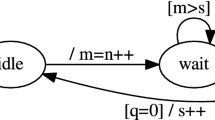Abstract
Theorem proving is a widely used approach to the verification of computer systems, and its theoretical basis is generally a proof system for formal derivation of logic formulas. In this paper, we propose a proof system for Propositional Projection Temporal Logic (PPTL) with indexed expressions, which is a unified temporal logic that subsumes the well-used Linear Temporal Logic (LTL). First, the syntax, semantics and logic laws of PPTL that allows indexed expressions are introduced, and the representation of LTL constructs by PPTL formulas is shown. Then, the proof system for the logic is presented which consists of axioms and inference rules for the derivation of both basic constructs and indexed expressions of PPTL. To show the capability of the proof system, several examples of formal proofs are provided. Finally, the soundness of the proof system is demonstrated.
This research is supported by the NSFC Grant Nos. 61751207, 61732013, 61672403, and 61572386.
Access this chapter
Tax calculation will be finalised at checkout
Purchases are for personal use only
Similar content being viewed by others
References
Bowman, H., Thompson, S.J.: A decision procedure and complete axiomatization of finite interval temporal logic with projection. J. Logic Comput. 13(2), 195–239 (2003)
Clarke, E.M., Grumberg, O., Peled, D.A.: Model Checking. The MIT Press, Cambridge (2000)
Duan, Z.: Temporal Logic and Temporal Logic Programming. Science Press, Beijing (2006)
Duan, Z., Tian, C.: A unified model checking approach with projection temporal logic. In: Liu, S., Maibaum, T., Araki, K. (eds.) ICFEM 2008. LNCS, vol. 5256, pp. 167–186. Springer, Heidelberg (2008). https://doi.org/10.1007/978-3-540-88194-0_12
Duan, Z., Tian, C.: A practical decision procedure for propositional projection temporal logic with infinite models. Theoret. Comput. Sci. 554, 169–190 (2014)
Duan, Z., Tian, C., Zhang, N., Ma, Q., Du, H.: Index set expressions can represent temporal logic formulas. Theoret. Comput. Sci. (2018). https://doi.org/10.1016/j.tcs.2018.11.030
Duan, Z., Yang, X., Koutny, M.: Framed temporal logic programming. Sci. Comput. Program. 70(1), 31–61 (2008)
Duan, Z., Zhang, N., Koutny, M.: A complete proof system for propositional projection temporal logic. Theoret. Comput. Sci. 497, 84–107 (2013)
French, T., Reynolds, M.: A sound and complete proof system for QPTL. In: Advances in Modal logic 2002, pp. 127–148 (2002)
Kanso, K., Setzer, A.: A light-weight integration of automated and interactive theorem proving. Math. Struct. Comput. Sci. 26(01), 129–153 (2016)
Kesten, Y., Pnueli, A.: Complete proof system for QPTL. J. Logic Comput. 12(5), 701–745 (2002)
Manna, Z., Pnueli, A.: Completing the temporal picture. Theoret. Comput. Sci. 83(1), 91–130 (1991)
Moszkowski, B.C.: Executing Temporal Logic Programs. Cambridge University, Cambridge (1986)
Moszkowski, B.C.: A complete axiom system for propositional interval temporal logic with infinite time. Log. Methods Comput. Sci. 8(3) (2012)
Pnueli, A.: The temporal logic of programs. In: Proceedings of the 18th Annual IEEE Symposium on Foundations of Computer Science, pp. 46–57. IEEE Computer Society (1977)
Rosner, R., Pnueli, A.: A choppy logic. In: LICS 1986, pp. 306–313 (1986)
Shu, X., Duan, Z.: A decision procedure and complete axiomatization for projection temporal logic. Theor. Comput. Sci. (2017). https://doi.org/10.1016/j.tcs.2017.09.026
Tian, C., Duan, Z.: Expressiveness of propositional projection temporal logic with star. Theoret. Comput. Sci. 412, 1729–1744 (2011)
Winskel, G.: The Formal Semantics of Programming Languages: An Introduction. The MIT Press, Cambridge (1993)
Zhang, N., Duan, Z., Tian, C.: Model checking concurrent systems with MSVL. Sci. China: Inf. Sci. 59(11), 101–118 (2016)
Author information
Authors and Affiliations
Corresponding authors
Editor information
Editors and Affiliations
Appendix
Appendix
This appendix presents the proof of Theorem 1.
Proof
We only need to prove the soundness of axioms and inference rules in \(\varPi _I\). The soundness of axioms and inference rules in \(\varPi _B\) has been proved in [8].
(IST) For any interval \(\sigma \), we have

which indicates \(\sigma \models \bigvee _{i\in \mathbb {N}}Q^i \leftrightarrow Q^*\). Recall that \(Q^*= \varepsilon \vee Q^+\).
(INS) For any interval \(\sigma \), we have
which indicates \(\sigma \models R[i] \rightarrow \bigvee _{i\in \mathbb {N}}R[i]\).
(INR) For any interval \(\sigma \), we have
which indicates \(\sigma \models \bigvee _{i\in \mathbb {N}}R[i] \leftrightarrow R[0]\vee \bigvee _{i\in \mathbb {N}}R[i+1]\).
(INA) For any interval \(\sigma \), we have
which indicates \(\sigma \models \bigvee _{i\in \mathbb {N}}P\wedge R[i] \leftrightarrow P\wedge \bigvee _{i\in \mathbb {N}}R[i]\). The proofs of (INO), (INN) and (INC) are similar.
(INM) Suppose \(\models R[i]\rightarrow R'[i]\). Then, for any interval \(\sigma \), \(\sigma \models R[i]\) implies \(\sigma \models R'[i]\). So, for any interval \(\sigma \), \(\sigma \models R[i]\) for some \(i\in \mathbb {N}\) implies \(\sigma \models R'[i]\) for some \(i\in \mathbb {N}\), which means \(\sigma \models \bigvee _{i\in \mathbb {N}}R[i]\) implies \(\sigma \models \bigvee _{i\in \mathbb {N}}R'[i]\), or equivalently \(\sigma \models \bigvee _{i\in \mathbb {N}}R[i]\rightarrow \bigvee _{i\in \mathbb {N}}R'[i]\).
(REF) Suppose \(\models R\leftrightarrow Q\vee P\wedge \bigcirc R\) and \(\models R\rightarrow \Diamond Q\). Then, \(R \equiv Q\vee P\wedge \bigcirc R\) and \(R \subset \Diamond Q\). According to Lemma 2, \(\bigvee _{i\in \mathbb {N}}P^{(i)} \wedge \bigcirc ^i Q \equiv R\), which means \(\models \bigvee _{i\in \mathbb {N}}P^{(i)} \wedge \bigcirc ^i Q \leftrightarrow R\). The proof of (REI) is similar. \(\square \)
Rights and permissions
Copyright information
© 2019 Springer Nature Switzerland AG
About this paper
Cite this paper
Zhao, L., Wang, X., Shu, X., Zhang, N. (2019). A Proof System for a Unified Temporal Logic. In: Du, DZ., Duan, Z., Tian, C. (eds) Computing and Combinatorics. COCOON 2019. Lecture Notes in Computer Science(), vol 11653. Springer, Cham. https://doi.org/10.1007/978-3-030-26176-4_55
Download citation
DOI: https://doi.org/10.1007/978-3-030-26176-4_55
Published:
Publisher Name: Springer, Cham
Print ISBN: 978-3-030-26175-7
Online ISBN: 978-3-030-26176-4
eBook Packages: Computer ScienceComputer Science (R0)




